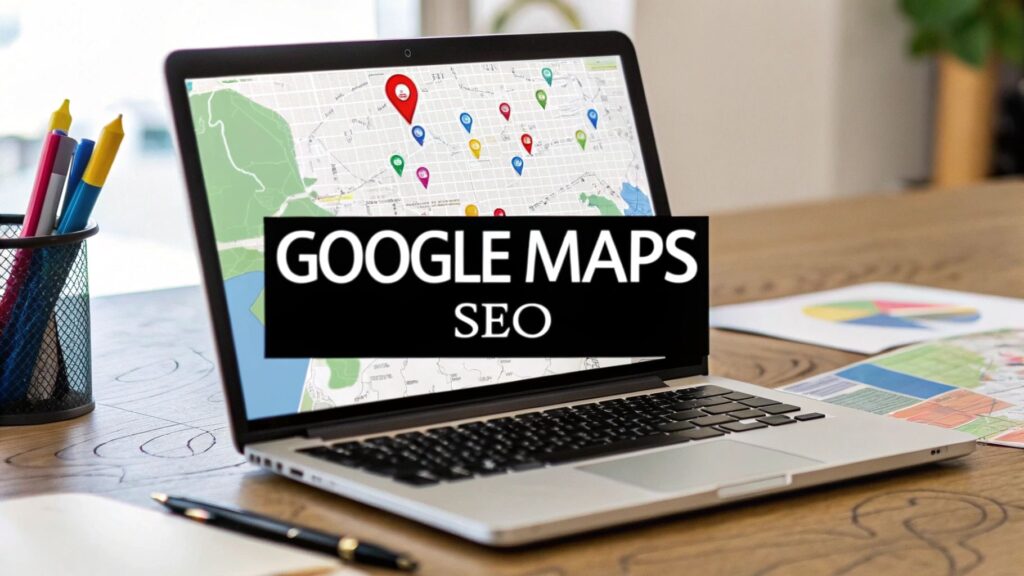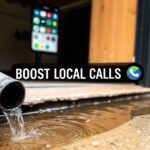When a car makes a funny noise or a check engine light flashes, people don't use the phone book anymore. They grab their phones and search for "mechanics near me" or "brake repair in [Your Town]."
This is where automotive repair SEO comes in. It’s all about making sure your shop is the first one they see in those search results. This puts you right in front of drivers when they need you most.
In short: Automotive repair SEO helps your shop show up at the top of Google when local customers search for the services you offer.
Why is SEO important for an auto repair shop?
Think of Google as the new main street for local businesses. If your auto repair shop doesn't show up online, you're invisible to most potential customers. A great local reputation still matters, but now that reputation has to exist online, too.
A smart SEO plan does more than just bring visitors to your website. It turns your site into a magnet for ready-to-book customers. We're talking about people actively looking for services you offer, like "Toyota oil change in Dallas." These are people ready to make an appointment.
Ditching Old-School Ads for Smarter Marketing
Remember flyers and newspaper ads? You spent money to cast a huge net, hoping to catch a few customers. SEO is different. It's a homing beacon that signals customers who are already searching for a solution.
A strong online presence builds trust before a customer even calls. When they see great reviews and a professional website, it tells them you’re a credible and reliable shop.
The Nuts and Bolts of a Winning SEO Game Plan
So, what does a solid SEO strategy look like for an auto shop? It’s not one magic trick. It's a combination of different efforts working together to boost your visibility.
Before we dive in, it’s good to get a bird’s-eye view of how the pieces fit together. For a deeper look, you can check out this comprehensive auto repair SEO strategy in this guide.
Here's a quick look at the essential pillars for any successful auto shop SEO strategy.
Core Components of Automotive Repair SEO
| SEO Component | Primary Focus | Key Goal |
|---|---|---|
| Local SEO | Google Business Profile, map rankings, and local citations. | Dominate the "map pack" for nearby searches and become the go-to shop in your area. |
| On-Page SEO | Your website's content, structure, and mobile-friendliness. | Make it easy for Google and customers to understand what you do and where you do it. |
| Trust Building | Online reviews, helpful blog content, and brand reputation. | Establish your shop as the trusted local expert that customers choose over competitors. |
Think of these three areas as the engine, chassis, and tires of your marketing. They all need to be in top shape. Focusing on these core areas creates a powerful online presence that turns clicks into customers.
Winning the Neighborhood with Hyperlocal SEO
General auto repair SEO is a good start. But to really own your local market, you have to get specific. It's not enough to just target your city name. You need to think smaller and more focused. This is where hyperlocal SEO comes in.
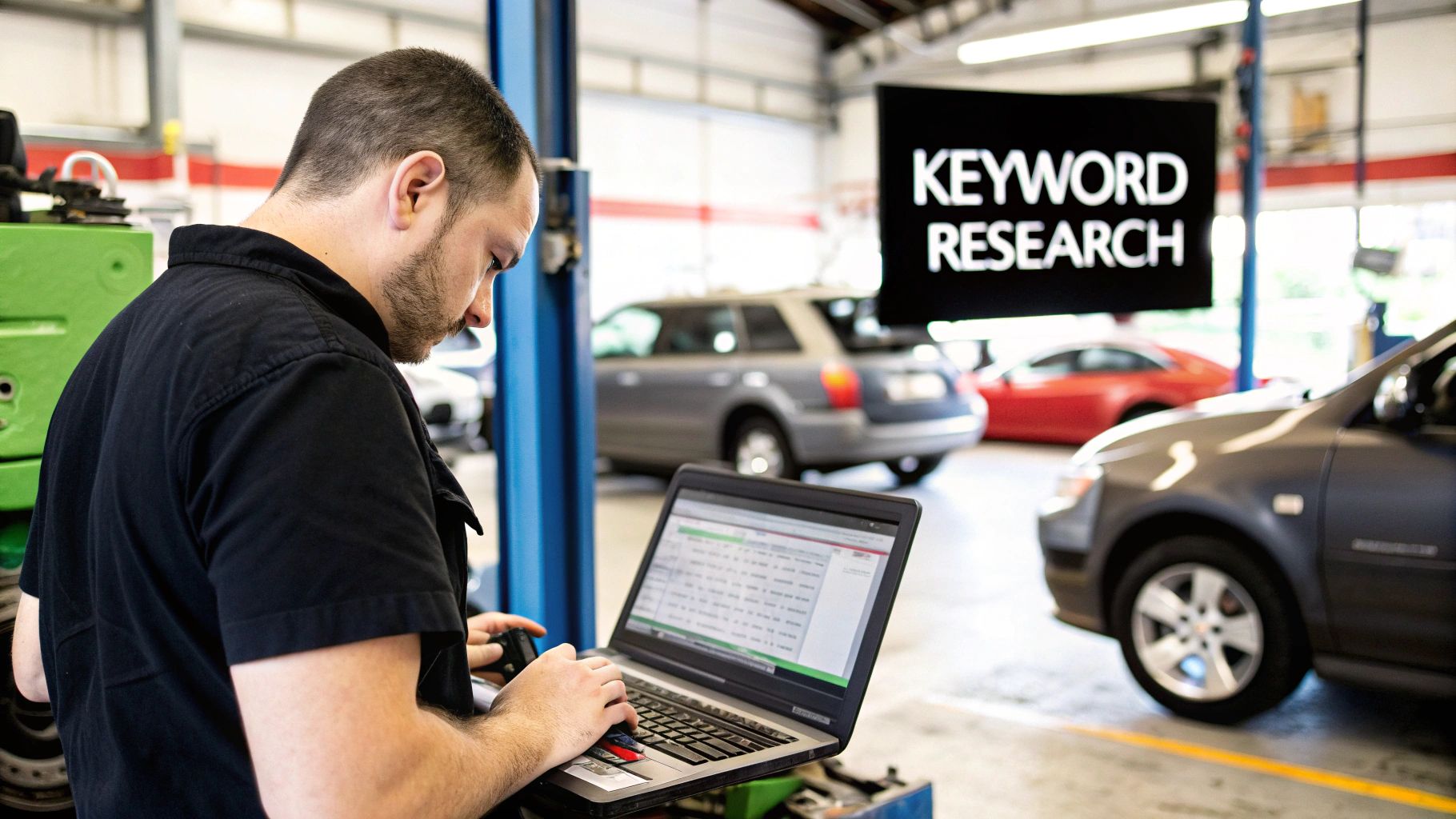
Instead of just "auto repair in Chicago," hyperlocal SEO targets things like "car service near Wrigleyville." You're targeting the specific neighborhoods and landmarks where your best customers live and work.
This approach makes your shop the most convenient choice for people searching in your backyard. When someone needs a quick oil change on their lunch break, they want a shop just a few blocks away.
Why Hyperlocal Targeting Works
Put yourself in your customer's shoes. A commuter whose car breaks down near their office will search for "emergency car repair near me." A parent with a flat tire after school drop-off will look up "tire patch near [School Name]." Using these specific local terms meets customers at their exact moment of need.
This strategy is effective because it lines up with how people search and what Google wants to deliver. Google's goal is to provide the most helpful, geographically relevant results possible.
Hyperlocal SEO is critical as Google's algorithm continues to prioritize user-focused content. Shops that use location-based keywords in their Google Business Profile are winning the top spots in the local map pack.
Weaving Hyperlocal Keywords into Your Online Presence
How do you do this? Sprinkle these neighborhood-specific terms across your entire digital footprint. This sends a powerful signal to Google that you're the go-to provider for a specific micro-area.
Your website is the natural place to start. Don't just stick your address on the contact page. Build dedicated service area pages that speak directly to the neighborhoods you serve.
A few ideas to get you started:
- A blog post titled, "Your Guide to Car Maintenance in the Downtown Core."
- A service page optimized for "Brake Repair for [Neighborhood Name] Residents."
- Mentioning nearby business parks on your "About Us" page.
Optimizing Your Google Business Profile for the Neighborhood
When it comes to hyperlocal SEO, your Google Business Profile (GBP) is your most powerful tool. It's often the first thing customers see when they search for you.
Here’s how to tune up your GBP:
- Be Specific with Service Areas: In your GBP settings, add specific neighborhood names and ZIP codes, not just your city.
- Use Local Terms in Your Description: Naturally work in phrases like "Proudly serving the [Neighborhood] community" or "Conveniently located near [Landmark]."
- Answer Local Questions: Use the Q&A section to add and answer your own questions. For instance: "Are you the closest mechanic to [Local College]?" Then answer it: "Yes, we are just a five-minute drive from [Local College], making us a convenient choice for students and faculty."
By using these hyperlocal signals, you're not just telling Google where you are. You're proving you are part of a specific community. For a guide on making your shop shine in map results, check out our article on mastering https://clicksgeek.com/local-maps-seo/.
People Also Ask About Local SEO for Auto Shops
-
How specific should my hyperlocal keywords be?
Be as specific as you can without sounding unnatural. Think about major crossroads, popular parks, and community hubs that locals use as reference points. -
Will targeting neighborhoods hurt my city-wide ranking?
No, it actually helps. By showing you're an authority in several micro-areas, you signal to Google that you're a major player in the broader city. -
Where else can I use hyperlocal terms?
Use them in your social media posts, on local directory listings like Yelp, and in the alt text for photos on your site. The more consistent you are, the stronger the signal.
Your Digital Garage: First Impressions Matter
Your website and your Google Business Profile (GBP) are the digital front door to your shop. This is where most potential customers will find you and decide whether to trust you with their vehicle.
Getting these two things right is a huge piece of the automotive repair seo puzzle. It's how you turn someone searching on their phone into a loyal customer. Your website is your 24/7 service advisor, and your GBP is your first impression.
Stop Lumping Everything Together: Build Out Your Service Pages
Many shops cram all their services onto one generic "Our Services" page. That’s a huge SEO mistake. Google wants to send users to the most specific, helpful result. A detailed page on "Brake Repair in Dallas" will always beat a general page that just lists "brakes."
You need a dedicated page for every single service you want to get calls for.
Start with the essentials:
- Brake Repair & Replacement
- Oil Change Services
- Tire Rotation & Wheel Alignment
- Check Engine Light Diagnostics
- A/C & Heating System Repair
- Transmission Repair
Each page should be built around that specific service keyword plus your city. Use simple language. Explain the service, talk about common symptoms, and end with a clear call to action like, "Schedule Your Free Brake Inspection Today."
In Short: Individual service pages give Google dozens of specific targets to rank. You’re no longer just a "mechanic." You're the local expert for brake jobs and the specialist for A/C repair.
Your Google Business Profile Is Non-Negotiable
For a local business like an auto repair shop, your Google Business Profile is probably your most important marketing tool. It’s what gets you into the "local pack" on Google Maps when someone searches for "mechanic near me." Getting this right is often the fastest way to make the phone ring.
This is your command center for what a customer sees on Google Search and Maps.
From this dashboard, you control your hours, services, photos, and, most importantly, your reviews.
Fine-Tuning Your Google Business Profile for Maximum Impact
Just claiming your profile isn't enough. The shops that dominate the local pack actively manage their profiles.
-
Get Your Categories Right: Your primary category must be "Auto Repair Shop." Add secondary categories for every major service, like "Tire shop," "Brake shop," and "Oil change station."
-
Write a Real Description: Tell people what makes you different. Are your techs ASE-certified? Mention your fair pricing. Weave in keywords naturally, like "your trusted family-owned mechanic in [Your City]."
-
Feed It a Steady Diet of Photos: Post photos of your clean bays, your equipment, and your friendly team. Try to add a new photo at least once a week. It shows Google you’re active.
-
Use the Q&A Feature Proactively: Add your own questions and answers. Think about what customers always ask. "Do you offer a warranty on your repairs?" or "Can I wait while you do my oil change?" This is another great spot for keywords.
The Make-or-Break Rule of NAP Consistency
One of the biggest trust signals for Google is consistency. Your Name, Address, and Phone number (NAP) must be 100% identical everywhere online. That means your website, GBP, Yelp, and Facebook page.
Even a tiny difference, like "St." on one site and "Street" on another, can confuse search engines and hurt your local rankings. Absolute consistency proves you're a real, established business.
Finally, remember most customers will find you on their phones. Your website must work flawlessly on a mobile device. For a closer look, check out this guide on how to build a mobile landing page.
Building Real Trust with Reviews and Expert Content
Getting a customer to click on your website is one thing. Getting them to trust you with their car is the real challenge. In auto repair, trust is earned through transparency and proving you know your stuff.
This is where online reviews and helpful content come in. When a driver sees a long list of happy customers and finds clear answers to their car questions, it builds instant confidence.
Your Reviews Are Your Reputation
Online reviews are the new word-of-mouth. A huge number of consumers say online reviews influence what they buy. For a business like auto repair, where trust is everything, what people say on platforms like Google and Yelp matters.
You need a simple, consistent way to ask happy customers to share their experience.
Here are a few easy ways to get more reviews:
- The Follow-Up Text: A day after service, a simple text works. "Hey [Customer Name], thanks for coming in! If you have a second, would you mind sharing your experience on Google? [Link]."
- The Countertop QR Code: Place a small sign with a QR code at your checkout counter that links right to your Google review page.
- The Personal Ask: When a customer is thanking you, just say it. "I'm glad we could help! A quick review on Google makes a huge difference for our shop if you have a moment."
In short: Make it as easy as possible to leave a review. The less friction, the more likely you are to get that 5-star rating.
You Have to Respond to Every Single Review
Getting reviews is step one. Responding to them—good and bad—is what separates the pros from the amateurs. It shows you’re paying attention and you care.
Responding to positive reviews is easy. A quick, "Thanks so much, [Customer Name]! We were happy to get you back on the road," reinforces the great experience.
Handling a negative review is even more important. Always respond professionally and publicly. Acknowledge their problem, say you want to make it right, and invite them to connect offline. This shows potential customers that you’re a professional who will step up.
Here’s a quick guide to help you frame your responses.
Effective Review Response Strategy
| Review Type | Key Objective | Example Response Snippet |
|---|---|---|
| Positive (5-Star) | Reinforce the positive experience and show appreciation. | "Thanks so much for the 5-star review, [Customer Name]! We're thrilled to hear you had a great experience." |
| Neutral (3-Star) | Acknowledge feedback and show you're always improving. | "We appreciate you taking the time to leave a review. Your feedback helps us improve." |
| Negative (1-2 Star) | Show accountability and move the conversation offline. | "We're very sorry to hear about your experience. That's not our standard. Please call me directly at…" |
By responding thoughtfully, you're demonstrating your shop's character to every future customer who reads that review.
This infographic breaks down the return on investment for two common content approaches.
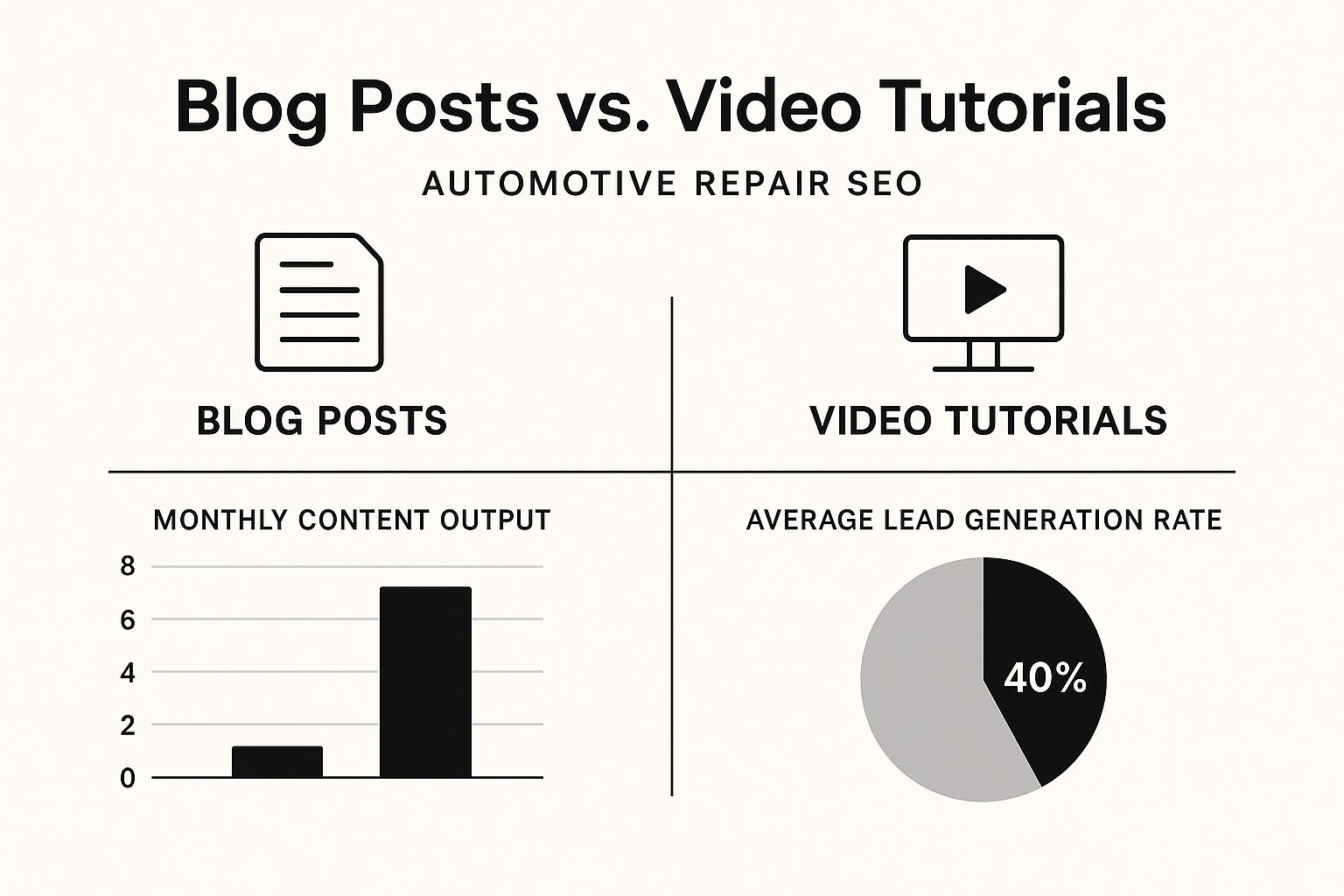
While a single video might generate more leads, consistently publishing blog posts often results in a higher overall number of leads.
Become the Go-To Car Expert in Town
Beyond reviews, creating useful content is the best way to prove you’re an authority. You don't need to be a professional writer. You just need to answer the questions your customers ask you every day.
People are constantly typing their car problems into Google. By creating simple blog posts that answer those questions, you put your shop right in front of them.
Content ideas that work:
- "5 Signs Your Brakes Are About to Fail"
- "Is Synthetic Oil Really Worth the Extra Cost?"
- "What That Blinking Check Engine Light Actually Means"
This kind of content helps your site show up in search results for specific, "long-tail" keywords. It also demonstrates your expertise and builds trust, making your shop the obvious choice.
Using Smart Tech to Boost Your SEO and Keep Customers Coming Back
Great auto repair SEO isn't just about keywords. The real secret is using technology to create a great customer experience that does the marketing for you. The right tools can automate follow-ups, simplify booking, and turn one-time customers into regulars.
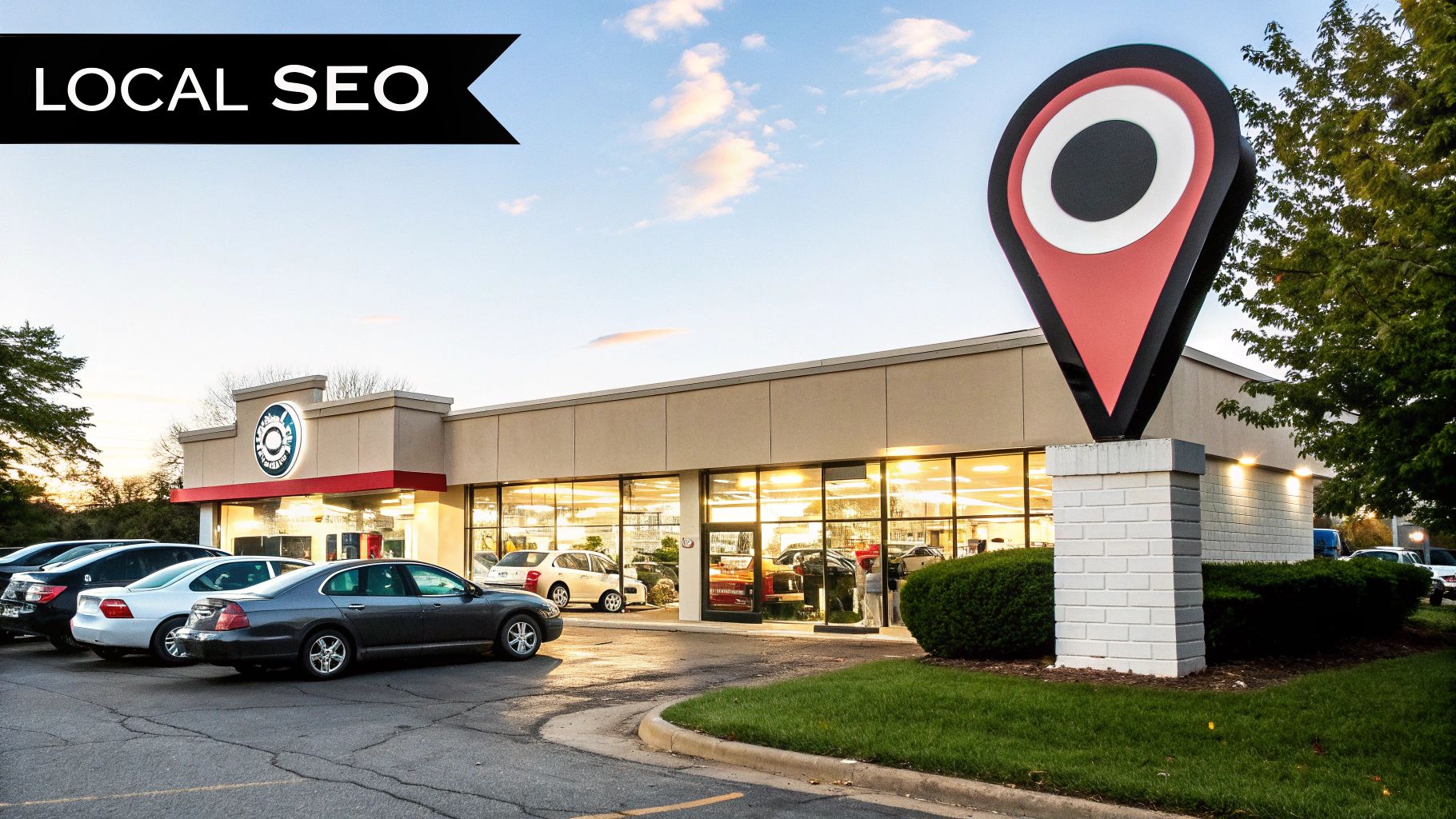
This is where your shop operations and digital marketing click together. When you use tech to make customers' lives easier, you get more positive reviews, increase customer value, and build a rock-solid local reputation. All of those are gold for your SEO.
How Does Tech Help My Shop's SEO?
SEO gets a new customer to call you. Technology makes sure they have a great experience and come back.
This creates a powerful cycle: better service leads to better online reviews. Better reviews push your shop higher in local search results. Higher rankings attract more new customers.
Simple automation tools take care of repetitive tasks. This frees you up to provide top-notch repairs and build relationships. It's like having a digital assistant who never forgets to send a service reminder or ask for a review.
Putting a CRM to Work for You
A Customer Relationship Management (CRM) system is a powerful tool for a modern auto shop. It’s your command center for all customer information.
But a good CRM is also an automation engine. You can set it up to automatically send messages at just the right time.
How a CRM directly impacts SEO and retention:
- Automated Service Reminders: Your CRM can send a text or email when a car is due for an oil change. This keeps your shop top-of-mind and your bays full.
- Targeted Marketing: You can send specials based on a customer's vehicle or past services. For example, an A/C check special sent to owners of older cars before summer.
- Post-Service Review Requests: A day after a repair, the CRM can automatically send a polite message asking for a Google review. This is the most effective way to build your 5-star reputation.
To get prospects from browsing to loyal customers, you need a solid follow-up plan. A CRM powers this process. If you're ready to get serious, you can learn how to master automated lead nurturing.
How do I use AI in my auto shop marketing?
"Artificial intelligence" might sound complex, but simple AI tools are now easy to use for small businesses. They're great for personalizing your marketing.
The auto repair industry is going digital. With most consumers on their smartphones, your communication has to be mobile-friendly. Tools that automate reminders are no longer a luxury. Personalizing your communication can boost customer retention by up to 20%.
A great place to start is with an AI-powered chatbot on your website. It can answer basic questions 24/7 and capture leads even when you're closed. Some tools can even analyze customer data to help you create smarter marketing campaigns without the guesswork.
People Also Ask: Your Biggest Questions About Auto Shop SEO
If you're running a busy shop, trying to understand automotive repair SEO can feel overwhelming. It’s normal to have questions about how this works.
Let's break down the most common ones with straight-up answers.
How long does it take for SEO to work for an auto repair shop?
This is the big one. The honest answer is, it depends. You can see quick wins in the first month or two, especially by cleaning up your Google Business Profile. Small tweaks there can give you a fast bump in the local map pack.
But for the really valuable stuff—ranking on the first page for competitive terms like "brake repair in Austin"—you need to be patient. It generally takes 4 to 6 months of consistent work to see that kind of traction. Think of it like building a reputation online, not flipping a switch.
In short: The first few months are about laying the groundwork. The real payoff, a steady stream of calls, comes after that foundation is solid.
Can I do SEO for my auto repair shop myself?
Yes, you can absolutely tackle a lot of the local SEO basics on your own. Getting your hands dirty is a great way to understand your online presence and see immediate progress.
Here’s what you can probably handle in-house:
- Your Google Business Profile: Claiming it and filling out every section is a weekend project that pays off.
- Getting More Reviews: Simply asking every happy customer for a review is one of the most powerful things you can do.
- Basic Website Updates: Adding new team photos or updating your services list is a perfect DIY task.
However, the more advanced stuff—technical SEO and building a real content strategy—gets complicated and takes a ton of time. Many shop owners start with the basics and then hire an agency when they're ready to step on the gas.
What's the real difference between Google Ads and SEO?
Great question. They both show up on Google but work in different ways. They are two different tools in your marketing toolbox and work best when used together.
- Google Ads is like renting prime real estate. You pay, and you get instant visibility at the top of the page. It's great for getting the phone to ring right now. The moment you stop paying, you disappear.
- SEO, on the other hand, is like owning your spot. It takes time to earn your rankings, but once you do, you get a steady flow of free, organic traffic. It’s a long-term asset that keeps paying you back.
Most successful shops use a mix—running Ads for quick wins while building a dominant, long-lasting presence with SEO.
Ready to stop guessing and start getting real results from your online marketing? The team at Clicks Geek specializes in turning search engine clicks into paying customers for local businesses just like yours. Learn more about how we can help your shop dominate the competition.
Is Your Business Ranking in Google Maps?
Turn Google Maps into a Lead Engine w/ Clicks Geek’s AI-powered local SEO. 3,000+ clients served. Our proprietary, fully done-for-you Maps SEO system handles everything—keyword targeting, local optimization, content, reviews, and ranking strategy—automatically.


